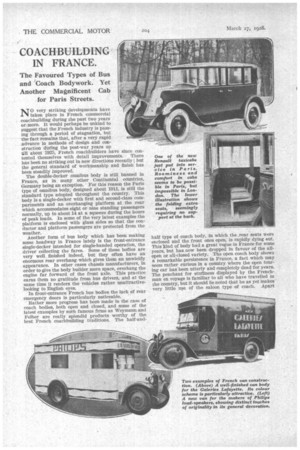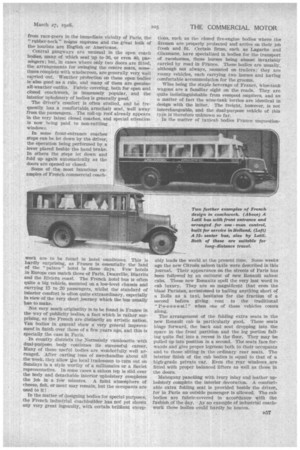COACHBUILDING IN FRANCE.
Page 118

Page 119

If you've noticed an error in this article please click here to report it so we can fix it.
The Favoured Types of Bus and Coach Bodywork. Yet Another Magnificent Cab for Paris Streets.
NO very striking developments have taken place in French commercial coachbuilding during the past two years or more. It would perhaps be unkind to suggest that the French industry is passing through a period of stagnation, but the fact remains that, after a very rapid advance in methods of design and construction during the post-war years up till about 1925, French coachbuilders have since contented themselves with detail improvements. There has been no striking out in new directions recently ; but the general standard of workmanship and finish has been steadily improved.
The double-decker omnibus body is still banned in France, as in many other Continental countries, Germany being an exception. For this reason the Paris type of omnibus body, designed about 1911, is still the standard type adopted throughout the country. This body is a single-decker with first and second-class compartments and an overhanging platform at the rear which accommodates eight or nine standing passengers normally, up to about 14 at a squeeze during the hours of peak loads. In some of the very latest examples the platform is enclosed with glass sides so that the conductor and platform passengers are protected from the weather.
Another form of bus body which has been making some headway in France lately is the front-entrance single-decker intended for single-handed operation, the driver collecting the fares. Some of these bodies are very well finished indeed, but they often have an enormous rear overhang which gives them an unwieldy appearance. In other cases chassis manufacturers, in order to give the body builder more space, overhang the engine far forward of the front axle. This practice earns them no gratitude from bus drivers, and at the same time it renders the vehicles rather unattractivelooking to English eyes.
In front-entrance French bus bodies the lack of rear emergency doors is particularly noticeable.
Rather more progress has been made in the case of coach bodies, both open and closed, and some of the latest examples by such famous firms as Weymann and Felber are really splendid products worthy of the best French coachbnilding traditions. The half-and
half type of coach body, in which the .rear seats were enclosed and the front ones open, is rapidly dying out. This kindof body had a great vogue in France for some years, but has now been dropped in favour of the allopen or all-closed variety. The open coach body shows a remarkable persistence in France, a fact which may seem rather curious in a country where the open touring car has been utterly and completely dead for years. The penchant for stuffiness displayed by the Frenchman en voyage is familiar to all who have travelled in the country, but it should be noted that he as yet Makes very little use of the saloon type of coach. Apart
from race-goers in the immediate vicinity of Paris, the `.` rubber-neck " reigns supreme and the .great bulk of the tourists are English or Americans.
Central gangways are unusual in the open coach bodies, many of which seat •up to-36, or even 40, passengers; but, in cases where only two doers are fitted, the arrangements for swinging the centre seats, sometimes complete with windscreen, are generally very well carried • out. Weather protection on these open bodies is also good as a rule, and many of them are genuine all-weather outfits. Fabric covering, both for open and closed coachwork, is immensely popular, and the interior upholstery of bodies is generally good.
The driver's comfort is often studied, and he frequently has a comfortable armchair seat, well away from the passengers. The roll-up roof already appears in the very latest closed coaches, and special attention is now being paid to non-rattling windows.
In some front-entrance coaches steps can be let down by the driver, the operation being performed by a lever placed beside the hand brake. in others the steps let down and fold up again automatically as the doors are opened. or closed.
Some of the most luxurious examples of French commercial coach
work are to be found in hotel • omnibuses. This is hardly surprising, as France is .essentially the land of the " palace " hotel in these days. Few hotels in Europe can match those of Paris, Deauville, Biarritz and the Riviera coast. The French hotel bus is often quite a big vehicle, mounted on a low-level chassis and carrying 15 to 20 passengers, whilst the standard of interior comfort is often quite extraordinary, especially in view of the very short journey which the bus usually has to make.
'Not very much originality is to be found in France in the way of publicity bodies, a fact which is rather surprising, as the French are distinctly an artistic nation. Van bodies in general show a very general improvement in finish over those of a few years ago, and this is specially the case in Paris.
In country districts the Normandy camionette with dual-purpose. body continues its successful career. Many of these useful bodies are wonderfully well arranged. After carting tons of merchandise about all the week, they allow the local tradesman to turn out on -Sundays in a style worthy of a millionaire or a Soviet representative. In some -cases a saloon top is slid over the body and detachable interior upholstery completes the job in a few minutes. A faint atmosphere of cheese, fish, or meat may remain, but the occupants are used to it !
In the matter of designing bodies for Special purposes, the French industrial coa.chbuilder has no yet shown any very great ingenuity, with certain brilliant excep tions, such as the closed fire-engine bodies where the firemen are properly protected and arrive on their job fresh and fit. Certain firms, such as Lagache and Glazmann, have specialized in bodies for the transport of raeehorses, these horses being almost invariably carried by road in France. These bodies are usually, although not always, mounted on trailers : they are roomy vehicles, each carrying two horses and having comfortable accommodation for the grooms.
Wine being the staple beverage of France, tivine-tank wagons are a familiar sight on the roads. They are quite indistinguishable from cesspool emptiers, and as a matter of fact the wine-tank lorries are identical in design with the latter. The freight, however, is not interchangeable, and the dual-purpose vehicle of this type is therefore unknown so far.
In the matter of taxicab bodies France unquestion ably leads the world at the present time. Some weeks ago the new Citroen saloon taxis were described in this journal. Their appearance on the streets of Paris has been followed by an outburst of new Renault saloon cabs. These new Renaults spell the very last word in . cab luxury. They are so magnificent that even the blase Parisian, accustomed to hailing anything short of a Rolls as a taxi, hesitates for the fraction of a second before giving vent to the traditional " P-s-s-s-s-s-st ! " when one of these vehicles comes along.
The arrangement of the folding extra seats in the new Renault cab is particularly good. These seats hinge forward, the back and seat dropping into the space in the front partition and the leg portion falling quite flat into a recess ha the floor. They may be pulled up into position in a second. The seats face forwards and give proper legroom both to their occupants and to those sitting in the ordinary rear seats. The interior finish of the cab bodies is equal to that of a high-grade private car. Even the rear windows are fitted with proper balanced lifters as well as those in the doors.
Mahogany panelling with ivory inlay and leather upholstery complete the interior decoration. A comfortable extra folding seat is provided beside the driver, for in Paris an outside passenger is allowed. The cab bodies are fabric-covered in accordance with the • fashion of the day. As an example of industrial coachwork these bodies could hardly be beaten. D57




























































































































































































